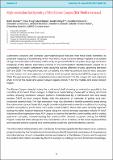Por favor, use este identificador para citar o enlazar a este item:
http://hdl.handle.net/10261/270875COMPARTIR / EXPORTAR:
 SHARE
BASE SHARE
BASE
|
|
| Visualizar otros formatos: MARC | Dublin Core | RDF | ORE | MODS | METS | DIDL | DATACITE | |

| Título: | High-resolution bathymetry of the Blanes Canyon (NW Mediterranean) |
Autor: | Durán, Ruth CSIC ORCID ; Puig, Pere CSIC ORCID ; Bilan, Meri; Grinyó, Jordi CSIC ORCID; Cabrera Molina, Cecilia; Lo Iacono, Claudio CSIC ORCID; Muñoz, Araceli; Huvenne, Veerle A.I.; Fabri, Marie-Claire; Guerin, Charline; ABRIC cruise team | Fecha de publicación: | 15-jun-2021 | Citación: | 5th International Network for Submarine Canyon Investigation and Scientific Exchange International Symposium (2021) | Resumen: | Submarine canyons are complex geomorphological features that have been identified as potential hotspots of biodiversity, which has led to many canyons being mapped and studied at high resolution (tens of meters). In this work, we present the first complete very-high resolution mapping of the Blanes submarine canyon in the northwestern Mediterranean, based on a compilation of swath bathymetry data acquired during different cruises, spanning between 2011 and 2020. The integrated data set completes and extends previous bathymetric datasets on the canyon rim and adjacent continental shelf acquired during the ESPACE programme in 2004. The grid spacing of the compilation map varies from 4 m for the canyon rim and adjacent shelf, 15 m for the head and upper canyon region and 25 m for the middle and lower canyon region. The Blanes Canyon deeply incises the continental shelf, showing an orientation parallel to the coastline at its head. Down-canyon, it displays a meandering course with a strong structural control, showing rectilinear canyon portions characterized by a flat-floored axis and steep terrains (>50º) on both canyon flanks, with the presence of networks of gullies and subhorizontal layered walls. The high resolution map has allowed to identify potential areas along the submarine canyon flanks that might provide suitable environmental conditions for hosting benthic ecosystems, particularly cold-water corals (CWCs). These sites were recently explored during the ABRIC Spanish National Project using the hybrid remotely operated vehicle (H-ROV) Ariane and the inspection-class ROV Liropus to explore the benthic communities and to collect specimen samples, complementing the previous ROV dataset acquired during the ABIDES Project. Collected data allowed for the compilation of an inventory of the most representative and relevant benthic species and communities observed within the Blanes Canyon. This information will be shared with the Blanes fishermen’s guild in the framework of an outreach project funded by the Fisheries Local Action Groups (GALP), to provide awareness of the presence and abundance of such vulnerable marine ecosystems in the Blanes Canyon, and to expand the spatial information provided by the ROV surveys by adding the local fishermen knowledg | Descripción: | 5th International Network for Submarine Canyon Investigation and Scientific Exchange International Symposium (INCISE), 14-18 June 2021 | URI: | http://hdl.handle.net/10261/270875 |
| Aparece en las colecciones: | (ICM) Comunicaciones congresos |
Ficheros en este ítem:
| Fichero | Descripción | Tamaño | Formato | |
|---|---|---|---|---|
| Duran_et_al_2021_poster.pdf | 765,47 kB | Adobe PDF |  Visualizar/Abrir | |
| Duran_et_al_2021_abstract.pdf | 41,32 kB | Adobe PDF |  Visualizar/Abrir |
CORE Recommender
NOTA: Los ítems de Digital.CSIC están protegidos por copyright, con todos los derechos reservados, a menos que se indique lo contrario.
